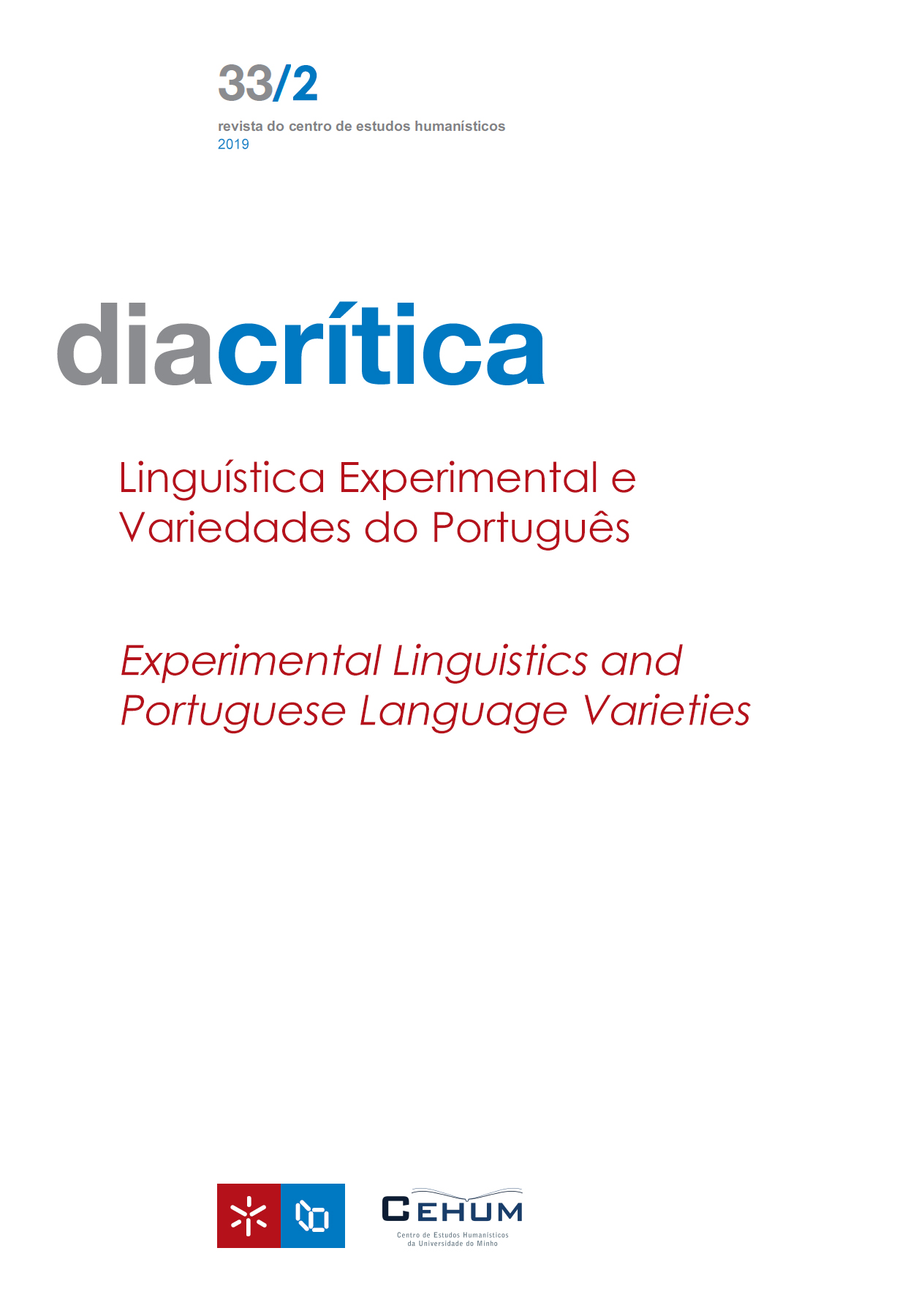Aprendizagem de categorias de palavras por análise distribucional resultados adicionais para Português Brasileiro
DOI:
https://doi.org/10.21814/diacritica.5063Palavras-chave:
Aquisição da linguagem, Aprendizagem de categorias, Análise distribucional, Modelagem CognitivaResumo
Uma criança adquirindo a língua deve descobrir quais são as categorias sintáticas em sua língua e atribuir palavras a uma ou mais delas. A questão que nos propomos a responder aqui é o quanto dessa aprendizagem pode ser realizada através da análise distribucional de enunciados. Para este fim, uma re-implementação do modelo computacional de Redington, Chater e Finch (1998) foi conduzida e aplicada a dados do Português Brasileiro, obtidos de corpora disponíveis publicamente, tanto com fala dirigida à criança, quanto com fala entre adultos. Os resultados de todos os experimentos são apresentados e discutidos. Estes experimentos investigam mais variáveis e aspectos envolvidos nesta tarefa de aprendizagem: tipos de contextos distribucionais, o número de palavras-alvo e de contexto assumidas, o valor da informação distribucional para as diferentes categorias, tamanho do corpus etc. Uma comparação entre a fala dirigida à criança e a fala entre adultos também é feita. Em geral, nossos resultados dão suporte aos de Redington et al. (1998), embora tenhamos encontrado algumas diferenças possivelmente importantes e até contraditórias. Também avaliamos a medida cosseno, comparando a performance obtida com ela à performance obtida com a correlação de Spearman usada no estudo de Redington et al. (1998). Esta última parece produzir melhor performance. Neste artigo, focamos numa análise quantitativa dos nossos resultados.Referências
Baroni, M. &Lenci, A. (2010). Distributional memory: A general framework for corpus-based semantics. Computational Linguistics, 36(4), 673–721. DOI: https://doi.org/10.1162/coli_a_00016
Bernal, S., Lidz, J., Millotte, S.& Christophe, A. (2007). Syntax constrains the acquisition of verb meaning. Language Learning and Development, 3, 325–341. DOI: https://doi.org/10.1080/15475440701542609
Berwick, R. C., Pietroski, P., Yankama, B. & Chomsky, N. (2011). Poverty of the stimulus revisited. Cognitive Science, 35, 1207–1242. DOI: https://doi.org/10.1111/j.1551-6709.2011.01189.x
Brown, R.W. (1957). Linguistic determinism and the part of speech. Journal of Abnormal & Social Psychology, 55(1), 1–5. DOI: https://doi.org/10.1037/h0041199
Clark, A. (2003). Combining distributional and morphological information for part of speech induction. In Proceedings of the Tenth Conference on European Chapter of the Association for Computational Linguistics –Volume 1, EACL’03(pp.59–66).Stroudsburg, PA, USA:Association for Computational Linguistics. DOI: https://doi.org/10.3115/1067807.1067817
Faria, P. (2019). The Role of Utterance Boundaries and Word Frequencies for Part-of-speech Learning in Brazilian Portuguese Through Distributional Analysis. In Proceedings of the Workshop on Cognitive Modeling and Computational Linguistics(NAACL’19), 152–159. DOI: https://doi.org/10.18653/v1/W19-2917
Faria, P. &Ohashi, G. O. (2018). A aprendizagem distribucional no português brasileiro: um estudo computacional. Revista LinguíStica,14(3),128–156. DOI: https://doi.org/10.31513/linguistica.2018.v14n3a21419
Frank, M. C. (2011). Computational models of early language acquisition. CurrentOpinion in Neurobiology,21(3), 381–386. https://doi.org/10.1016/j.conb.2011.02.013. DOI: https://doi.org/10.1016/j.conb.2011.02.013
Galves, C.,Andrade, A. L. de & Faria, P. (2017). Tycho Brahe Parsed Corpus of Historical Portuguese. <http://www.tycho.iel.unicamp.br/corpus/en/>. DOI: https://doi.org/10.1075/lv.00004.gal
Harris, Z.S. (1954). Distributional structure. Word, 10(2-3),146–162. DOI: https://doi.org/10.1080/00437956.1954.11659520
Kaplan, F., Oudeyer, P.-Y. & Bergen, B. (2008). Computational models in the debate over language learnabiliy. Infant and Child Development, 17(1), 55–80. DOI: https://doi.org/10.1002/icd.544
Landau, B.&Gleitman, L. R. (1985). Language and experience: evidence from the blind child. Harvard University Press, Cambridge, MA.
Lenci, A. (2018). Distributional models of word meaning. AnnualReview ofLinguistics, 4,151–171. DOI: https://doi.org/10.1146/annurev-linguistics-030514-125254
Hirsh-Pasek, K., Kemler Nelson, D. G., Jusczyk, P. W., Cassidy, K. W., Druss, B. & Kennedy, L. (1987). Clauses are perceptual units for young infants. Cognition, 26(3), 269–286. DOI: https://doi.org/10.1016/S0010-0277(87)80002-1
MacWhinney, B. (2000). The CHILDES Project: Tools for analyzing talk, third edition. Lawrence Erlbaum Associates, Mahwah, NJ.
Mikolov, T., Sutskever, I., Chen, K., Corrado, G. & Dean, J. (2013). Distributed representations of words and phrases and their compositionality. In Proceedings of the 26th International Conference on Neural Information Processing Systems –Volume 2, NIPS’13(pp.3111–3119).Lake Tahoe, NV, USA:Curran Associates Inc.
Pennington, J., Socher, R. & Manning, C. D. (2014). Glove: Global vectors for word representation. EMNLP, 14, 1532–1543. DOI: https://doi.org/10.3115/v1/D14-1162
Pullum, G. K. (1996). Learnability, hyperlearning, and the poverty of the stimulus. In Proceedings of the Twenty-Second Annual Meeting of the Berkeley Linguistics Society: General Session and Parasession on The Role of Learnability in Grammatical Theory(pp.498–513). Berkeley, California: Berkeley Linguistics Society. DOI: https://doi.org/10.3765/bls.v22i1.1336
Redington, M., Chater, N. & Finch, S. (1998). Distributional information: A powerful cue for acquiring syntactic categories. Cognitive Science, 22(4), 425–469. DOI: https://doi.org/10.1207/s15516709cog2204_2
Seidenberg, M. S. (1997). Language acquisition and use: Learning and applying probabilistic constraints. Science, 275(14), 1599–1603. DOI: https://doi.org/10.1126/science.275.5306.1599
Snow, C. E. (1977). The development of conversation between mothers and babies. Journal of Child Language, 4, 1–22. DOI: https://doi.org/10.1017/S0305000900000453
Tomasello, M. (1995). Language is not an instinct. Cognitive Development, 10, 131–156. DOI: https://doi.org/10.1016/0885-2014(95)90021-7
Turney, P. D. & Pantel, P. (2010). From frequency to meaning: Vector space models of semantics. Journal of Artificial Intelligence Research, 37(1), 141–188. DOI: https://doi.org/10.1613/jair.2934
Wintner, S. (2010). Computational Models of Language Acquisition. InA. Gelbukh (Ed.),Proceedingsof the 11th international conference on Computational Linguistics and Intelligent Text Processing(CICLing'10)(pp. 86–99).Berlin, Heidelberg: Springer-Verlag. http://dx.doi.org/10.1007/978-3-642-12116-6_8 DOI: https://doi.org/10.1007/978-3-642-12116-6_8
Yang, C.(2002). Knowledge and learning in natural language. Oxford: Oxford University Press.
Yang, C. (2012).Computational models of syntactic acquisition. Wiley Interdisciplinary Reviews: Cognitive Science, 3,205–213. http://dx.doi.org/10.1002/wcs.1154 DOI: https://doi.org/10.1002/wcs.1154
Downloads
Publicado
Como Citar
Edição
Secção
Licença
Direitos de Autor (c) 2023 Pablo Faria

Este trabalho encontra-se publicado com a Creative Commons Atribuição-NãoComercial 4.0.










